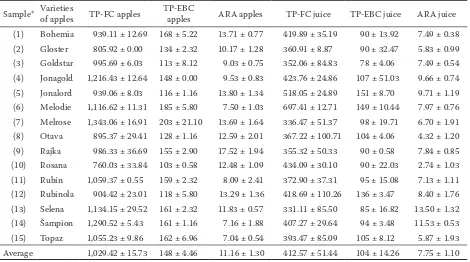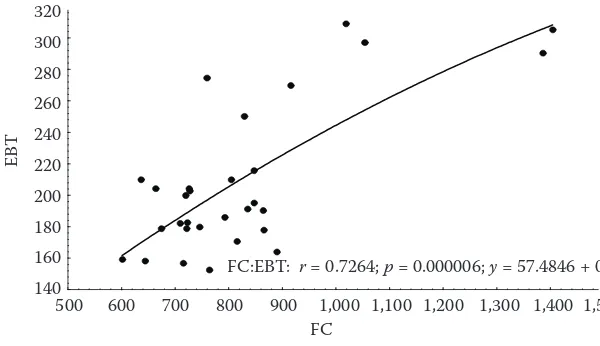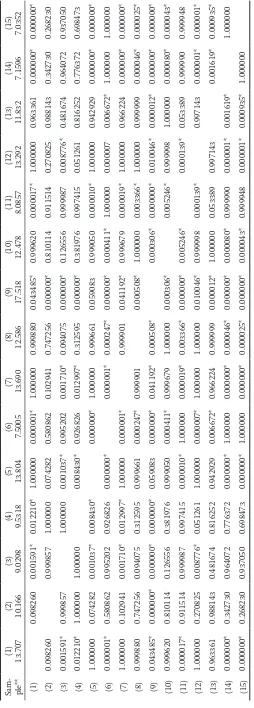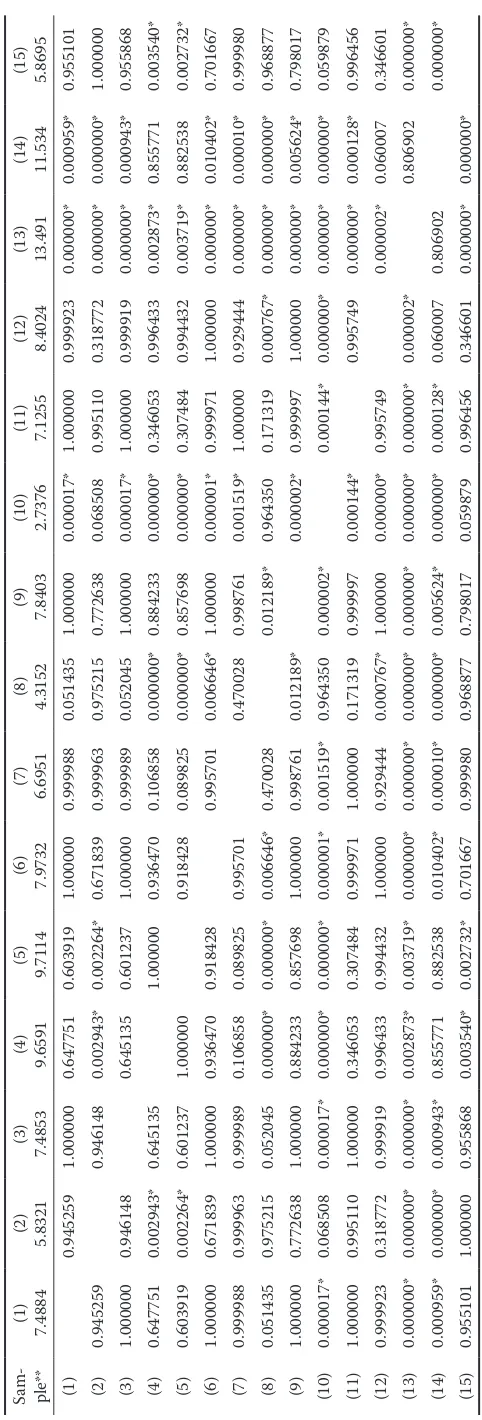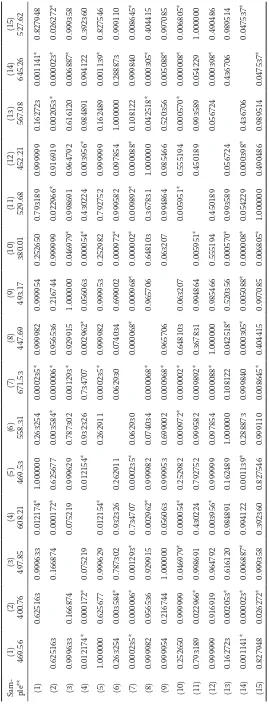Consumption of fruits or vegetables has been shown to be effective in the prevention of heart and cardiovascular diseases and atherosclerosis (Stangl et al. 2005). These benefits are often attributed to the high antioxidant content of some plant resources. Besides size, shape, colour and taste of the fruit, a new quality parameter is becoming more and more popular – a bioactivity of the fruit and its health-promoting effect for the consumer (Schirrmacher, Schempp 2003). Apples are commonly eaten and are large contributors of phenolic compounds in European and North American diets (Wolfe et al. 2003). Apples are commonly eaten in Middle Europe during the whole growth period and are large contributors of secondary plant metabolites in hu-man diets (Schmitz-Eiberger et al. 2003). Though the antioxidant activity is caused both, by phenolic compounds and ascorbic acid, it was demonstrated by Gliszczynska-Swiglo and Tyrakowska (2003) that Trolox® equivalent antioxidant capa-
city (TEAC) value depends mainly on their polyphe-nol content. Apples are a major source of flavonoids in Western diet (Lachman et al. 2000a) and they may help to protect against chronic diseases with their antioxidant mechanisms (Lotito, Frei 2004). Correlation studies showed that total phenolic compounds contribute strongest to the TEAC anti-oxidant value of apple while the contribution of ascorbic acid seemed to be low. Flavonols, flavanols, procyanidins, dihydrochalcones, and hydroxycin-namates were the identified phenolic classes in peel tissue, and the most abundant compounds are epicatechin, procyanidin 132, and phloridzin (Chin-nici et al. 2004). The major phenolics in pulps were procyanidins and hydroxycinnamates and flavonols in amounts < 20 mg/kg fresh weight (FW). Some of them serve as substrates to enzymic browning of apple tissue by the effect of polyphenol oxidases (Lachman et al. 2000b). The antioxidant activi-ties comprised contributions from polyphenols,
Supported by the Ministry of Education, Youth and Sports of the Czech Republic, Research Project No. MSM 6046070901.
Polyphenol content and antiradical activity in different
apple varieties
J. Lachman
1, M. Šulc
1, J. Sus
2, O. Pavlíková
21
Department of Chemistry, Faculty of Agrobiology, Food and Natural Resources,
Czech University of Agriculture in Prague, Prague, Czech Republic
2
Department of Horticulture and Landscape Architecture, Faculty of Agrobiology,
Food and Natural Resources, Czech University of Agriculture in Prague, Prague, Czech Republic
ABSTRACT: Polyphenols are important antioxidant constituents of apples and they contribute positively to human health because they possess an antiradical activity. Fifteen apple varieties were analysed for their total polyphenol content (TP) by two methods – by Folin-Ciocalteau reagent (FC) and by EBC method with carboxylmethylcellulose/sodium ethylendiamintetraacetate (CMC/EDTA) and their antiradical activity (ARA) by DPPH method using stable free radi-cal 1,1-diphenyl-2-picrylhydrazyl (DPPH·). TP and ARA were determined in freshly expressed apple juice and apples and obtained results were statistically evaluated. The differences between varieties were significant. The correlation between TP content determined by FC method determining all free aromatic hydroxyls and EBC method determining mainly ortho-aromatic hydroxyls was found with r = 0.73. The highest differences among analysed varieties were found for ARA values in both, juice and apples and for TP content determined by FC in apples. High polyphenol content was found in Jonagold, Jonalord, Melodie and Melrose varieties both, in apples and juices; on the contrary low TP contents were estimated in Gloster and Rosana varieties. The highest ARA levels were found in Rajka, Bohemia and Melrose varieties, compared to low ARA levels found in apple fruits of Šampion and Topaz varieties.
phenolic acids, and flavonoids and correlated well with polyphenols and flavonoids (0.9207) (Leon-towicz et al. 2003). Also Lee et al. (2003) confirm that flavonoids such as quercetin, epicatechin, and procyanidin B-2 rather than vitamin C contribu-te significantly to the total antioxidant activity of apples. A highly linear relationship (R2 > 0.97) was attained between concentrations and total antioxidant capacity of phenolics and vitamin C. Among individual compounds the estimated con-tribution of major phenolics and vitamin C to the total antioxidant capacity of 100 g of fresh apples expressed in vitamin C equivalent antioxidant capac-ity (VCEAC) was: quercetin (40.39) > epicatechin (23.10) > procyanidin B-2 (22.07) > vitamin C (12.80) > phloretin (9.11) > chlorogenic acid (8.75). In ap-ples five major polyphenolic groups with the total of sixteen individual compounds were found, among which the dihydroxycinnamic acid esters, phloretin glycosides, and flavan-3-ols were found in both flesh and peel, whereas quercetin glycosides were almost exclusively found in the peel (Tsao et al. 2003). In both apple peel and flesh, the predominant group of polyphenolics was the procyanidins, followed by quercetin glycosides in the peel and hydroxycin-namic acid esters in the flesh. Compared to the pulp of the apples, skin-extracts show a higher antioxidant potential (Schirrmacher, Schempp 2003). Wolfe et al. (2003) confirmed that within each variety, the
total phenolic and flavonoid contents were signifi-cantly the highest in the peels, followed by the flesh. As Chinnici et al. (2004) discovered, among the single classes of compounds, procyanidins (in peels and pulps) and flavonols (in peels) statistically cor-related to the total antioxidant capacity.
Content of polyphenolic antioxidants is affected by many factors, mainly by apple variety (Davey, Keulemans 2004; Wolfe et al. 2003; Schmitz- Eiberger et al. 2003), fruit development (Kondo et al. 2002), conditions during long-term storage (Leja et al. 2003), superficial scald development in apple fruit (Fernandez-Trujillo et al. 2003), and solar radiation (Colavita et al. 2004). The aim of this study was to compare the content of total phenolics and antioxidant activity of fifteen apple varieties.
MATERIAL AND METHODS
[image:2.595.64.534.481.743.2]Plant material and its preparation: Fruits from 15 apple varieties (Table 1) were obtained from apple trees growing on Experimental Station of Czech Uni-versity of Agriculture in Prague in Troja, on Research and Breeding Institute of Pomology in Holovousy and on Research Institute of Plant Production in Prague-Ruzyně from the harvest in 2004. The ap-ples were harvested in proper harvest maturity of the given variety and analysed in consumer maturity 50 to 60 days after the harvest. One portion of fresh
Table 1. Total antiradical activity ARA (%) and polyphenol content TP in apple juice (mg/l) and apples (mg/kg FW) of 15 apple varieties (average ± STD)
Sample* Varieties of apples TP-FC apples TP-EBC apples ARA apples TP-FC juice TP-EBC juice ARA juice
apples (five apple fruits of each variety) was liquidised and apple juice obtained by pressing through gauze was percolated with N2 for 5 min and left stand in the 20 ml test tubes sealed with paraffin in the refrigera-tor in the dark for ca. 1 hour before analysis. Other portion of fresh samples (obtained from five apple fruits of each variety) was after liquidising extracted with 80% water ethanol in darkness and left at laboratory temperature for seven days. The weight of samples represented 10 g. Obtained extracts were converted into 100 ml volumetric flask and adjusted with 80% water ethanolic solution to the mark. 0.5 ml aliquots were pipetted for the determination.
Determination of total phenolics (TP) by Folin-Ciocalteau (FC) method: For the determination of total polyphenols the adjusted method (Lachman et al. 2000c) with Folin-Ciocalteau reagent was used. Sample (0.5 ml) was pipetted into 50 ml volumetric flask and diluted with distilled water. Then 2.5 ml of Folin-Ciocalteau reagent was added and after agita-tion 7.5 ml of 20% sodium carbonate soluagita-tion was added. After 2 hours standing at laboratory tem-perature absorbance of samples was measured on the spectrophotometer Heλios γ (Spectronic Unicam, GB) at wavelength λ = 765 nm against blank. Results were expressed as gallic acid equivalents (in mg/kg fresh matter – FM in the case of fresh material and mg/l in the case of apple juice, gallic acid Merck, D). Average results were obtained from three parallel determinations.
Determination of total phenolics (TP) by EBC method by Basařová et al. (1993): Into 25 ml volumetric flask to 10 ml of apple sample, 8 ml of car-boxylmethylcellulose/sodium ethylendiamintetra- acetate (CMC/EDTA) and 0.5 ml ammonium ferric citrate solutions were added. After thorough agita-tion 0.5 ml dilute ammonia soluagita-tion was added and after agitation the flasks were adjusted with distilled
water till the mark. After 10 minutes standing at laboratory temperature absorbance of samples was measured on the spectrophotometer Heλios γ (Spectronic Unicam, GB) at wavelength λ = 600 nm against blank. Blank: Into 25 ml volumetric flask to 10 ml of apple sample 8 ml of CMC/EDTA and 0.5 ml diluted ammonia solutions were added and then the volume was adjusted with water to the mark. CMC/EDTA solution: 10 g CMC and 2 g EDTA was diluted in water (ca. 1.5 hrs) in a 1,000 ml volumetric flask and filtered. CMC with low viscosity (Merck, Germany) was used. Ammonium ferric citrate solu-tion: 3.5 g ammonium ferric citrate (green powder) was diluted in water in 100 ml volumetric flask. Ammonia solution: 1 part of concentrated ammonia solution was diluted in 2 parts of distilled water. TP was calculated as TP = A600 × 820, where TP are total phenolics (mg/l) and A600 is measured absorbance. Average results were obtained from three parallel determinations.
Determination of antiradical activity (ARA) by DPPH· method: ARA was measured after the reac-tion with free stable radical 1,1-diphenyl-2-picryl-hydrazyl (DPPH·) according to Molyneux (2004). Fresh solution of DPPH in the concentration of 25 mg DPPH in 1 l of methanol should be prepared before the determination. 3 ml of violet DPPH solution is pi-petted into plastic cuvettes of 10 mm length and ab-sorbance is measured (t0) at wavelength λ = 515 nm on the spectrophotometer Heλios γ (Spectronic Uni-cam, GB). Then 5 μl of sample is added and after stir with the hand stirrer in cuvettes the reaction mixture is left to stand for 5 min. The absorbance is measured again (t5) and ARA is calculated from the decrease of absorbance in % according to relation: % of inactiva-tion = 100 – [(At5/At0) × 100]. Average results were obtained from seven parallel determinations and expressed as % of inactivation. It is also possible to
EBT = -0.3876+0.307*x-6.2083E-5*x^2
500 600 700 800 900 1000 1100 1200 1300 1400 1500 FC
140 160 180 200 220 240 260 280 300 320
EB
T
FC : EBT: r = 0.7264; p = 0.000006; y = 57.4846 + 0.183*x 320
300 280 260 240 220 200 180 160 140
500 600 700 800 900 1,000 1,100 1,200 1,300 1,400 1,500 EBT = – 0.3876 + 0.307x – 6.2083E – 5x2
EB
T
FC
[image:3.595.62.362.583.756.2]FC:EBT: r = 0.7264; p = 0.000006; y = 57.4846 + 0.183x
Ta
ble 2. S
cheff é v ar ianc e analy sis b etwe en v ar ie tie s f or A
RA in a
pple s Sam- ple** (1) 13.707 (2) 10.166 (3) 9.0298 (4) 9.5318 (5) 13.804 (6) 7.5005 (7) 13.690 (8) 12.586 (9) 17.518
(10) 12.478 (11) 8.0857 (12) 13.292 (13) 11.832 (14) 7.1596 (15) 7.0352
(1) 0.098260 0.001591* 0.012210* 1.000000 0.000001* 1.000000 0.999880 0.043485* 0.999620 0.000017* 1.000000 0.963361 0.000000* 0.000000* (2) 0.098260 0.999857 1.000000 0.074282 0.580862 0.102941 0.747256 0.000000* 0.810114 0.911514 0.270825 0.988143 0.342730 0.268230 (3) 0.001591* 0.999857 1.000000 0.001037* 0.995202 0.001710* 0.094075 0.000000* 0.126556 0.999987 0.008776* 0.481674 0.964072 0.937050 (4) 0.012210* 1.000000 1.000000 0.008430* 0.926826 0.012997* 0.312595 0.000000* 0.381976 0.997415 0.051261 0.816252 0.776372 0.698473 (5) 1.000000 0.074282 0.001037* 0.008430* 0.000000* 1.000000 0.999661 0.059083 0.999050 0.000010* 1.000000 0.942929 0.000000* 0.000000* (6) 0.000001* 0.580862 0.995202 0.926826 0.000000* 0.000001* 0.000247* 0.000000* 0.000411* 1.000000 0.000007 0.006672* 1.000000 1.000000 (7) 1.000000 0.102941 0.001710* 0.012997* 1.000000 0.000001* 0.999901 0.041192* 0.999679 0.000019* 1.000000 0.966224 0.000000* 0.000000* (8) 0.999880 0.747256 0.094075 0.312595 0.999661 0.000247* 0.999901 0.000508* 1.000000 0.003366* 1.000000 0.999999 0.000046* 0.000025* (9) 0.043485* 0.000000* 0.000000* 0.000000* 0.059083 0.000000* 0.041192* 0.000508* 0.000306* 0.000000* 0.010046* 0.000012* 0.000000* 0.000000* (10) 0.999620 0.810114 0.126556 0.381976 0.999050 0.000411* 0.999679 1.000000 0.000306* 0.005246* 0.999998 1.000000 0.000080* 0.000043* (11) 0.000017* 0.911514 0.999987 0.997415 0.000010* 1.000000 0.000019* 0.003366* 0.000000* 0.005246* 0.000139* 0.053389 0.999990 0.999948 (12) 1.000000 0.270825 0.008776* 0.051261 1.000000 0.000007* 1.000000 1.000000 0.010046* 0.999998 0.000139* 0.997143 0.000001* 0.000001* (13) 0.963361 0.988143 0.481674 0.816252 0.942929 0.006672* 0.966224 0.999999 0.000012* 1.000000 0.053389 0.997143 0.001619* 0.000935* (14) 0.000000* 0.342730 0.964072 0.776372 0.000000* 1.000000 0.000000* 0.000046* 0.000000* 0.000080* 0.999990 0.000001* 0.001619* 1.000000 (15) 0.000000* 0.268230 0.937050 0.698473 0.000000* 1.000000 0.000000* 0.000025* 0.000000* 0.000043* 0.999948 0.000001* 0.000935* 1.000000 * S ig ni fic an t d iff er en ce a t P < 0 .0 5 ** (1 ) B oh em ia , ( 2) G lo st er , ( 3) G ol ds ta r, (4 ) J on ag ol d, (5 ) J on al or d, (6 ) M el od ie , ( 7) M el ro se , ( 8) O ta va , ( 9) R aj ka , ( 10 ) R os an a, (1 1) R ub ín , ( 12 ) R ub in ol a, (1 3) S el en a, (1 4) Š am pi on , (1 5) T op az
make the calibration curve of ascorbic acid (Sigma). R2 for ascorbic acid is 0.9991.
Statistical evaluation: The results [three parallel determi-nations from three (TP/EBC) and seven parallel determina-tions (ARA)] were statistical-ly evaluated with Statistica 7.0 programme by the analysis of variance with multiple group-ing. More detailed evaluation was performed by Scheffé test at α = 0.05.
RESULTS AND DISCUSSION
va-rieties 261–970 mg/l were determined. High polyphenol content was found in apples and juices of Jonagold, Jonalord, Melodie and Melrose varieties. On the contrary low TP contents was estimated in apple fruits of Rosana and Gloster varieties, which corre-sponds to low TP content in juices. The high-est ARA levels were found in Rajka, Bohemia and Melrose varieties contrary to low ARA levels found in Šampion and Topas varieties, which does not unambiguously correspond to their low antioxidant antiradical activities in juices (Table 1).
We agree with the results obtained by Schmitz-Eiberger et al. (2003) and Schirr- macher and Schempp (2003) that the high content of total polyphenols was demon-strated in Jonagold and Jonalord varieties with high antiradical activity in apples and juices. Leja et al. (2003) estimated relatively high total polyphenols in Jonagold and Šampion varieties, but in their results Jonagold variety showed total phenols higher in comparison with Šampion, while the contents of anthocyanins were comparable. In their work the increase of the antioxidant activity during storage correlated with an increase of the concentration of catechin and phloridzin and this ascertainment was also confirmed by Napolitano et al. (2004). Thus the loss of L-ascorbic acid during stor-age among the early varieties could be bal-anced by the increase of total polyphenols (Davey, Keulemans 2004).
A relatively good correlation between TP content determined by FC method and EBC method was found with r = 0.73 (Fig. 1) despite the fact, that contrariwise to FC method EBC method determines only free ortho-dihydroxy groups (Basařová et al. 1993). The highest differences among ana-lysed varieties were found for ARA values in both, juice and apples and for TP content determined by FC in apples (Tables 2 to 4). The differences between varieties were significant. Like Arnous et al. (2001) in red wines, we found only a non-significant link between the antiradical activity and the total phenolics suggesting that flavanols, esp. proanthocyanidins could be the class of polyphenols that account for hydroxyl free radical scavenging efficacy at a great deal (Vanzani et al. 2005). This could be caused by different amounts of individual phenolics
[image:5.595.78.319.49.759.2]Ta
ble 3. S
cheff é v ar ianc e analy sis b etwe en v ar ie tie s f or A
RA in a
pple juic e Sam- ple** (1) 7.4884 (2) 5.8321 (3) 7.4853 (4) 9.6591 (5) 9.7114 (6) 7.9732 (7) 6.6951 (8) 4.3152 (9) 7.8403
(10) 2.7376 (11) 7.1255 (12) 8.4024 (13) 13.491 (14) 11.534 (15) 5.8695
constituting apple phenolic complexes of varieties with different antioxidant and antiradical efficiency. Vanzani et al. (2005) estimated that polyphenols contributed from 47% (Granny Smith) to 78% (Braeburn), with an average value of 54% to the total antioxidant efficiency experimentally measured in the apple extracts. However, Tsao et al. (2005) found significant corre-lations between polyphenol content and the Trolox equivalent antioxidant capacity value (TEAC) and Glisz-czynska-Swiglo and Tyrakowska (2003) between total phenolic content and the ferric reducing/antioxidant power. No correlations for vitamin C indicated that the TEAC value of ap-ple juices and apap-ples depends mainly on their polyphenol content (Vanza-ni et al. 2005). In agreement with the results obtained by Wang et al. (1996) who estimated the total antioxidant activity of twelve fruits and five com-mercial fruit juices using automated oxygen radical absorbance capacity (ORAC) assay and apples classified as average antioxidant sources among fruits. Interesting fact was that the contribution of the fruit pulp fraction to the total ORAC activity of fruit was less than 10%. DPPH does react neither with flavonoids that contain no OH-groups in B-ring (Yoko-zawa et al. 1998) nor with aromatic acids containing only one OH-group (Roginsky, Lissi 2005; von Gadov et al. 1997). It is interesting that TP contents in apple juices or apples determined by EBC are comparable to those found for beers (Basařová et al. 1993).
Some novel production meth-ods (Van der Sluis et al. 2004) use selected apple varieties (Jonagold, Elstar, Golden Delicious) for the pro-duction of enriched juice by applying an alcoholic extraction either on the pulp or on the pomace with the anti-oxidant activity 5 times higher than in conventional apple juice. The high content of polyphenolic antioxidants in some varieties, especially in Jona-gold, Jonalord, Melodie, and Melrose
[image:6.595.79.348.55.770.2]Ta
ble 4. S
cheff é v ar ianc e analy sis b etwe en v ar ie tie s f
or TP FC in a
pple s Sam- ple** (1) 469.56 (2) 400.76 (3) 497.85 (4) 608.21 (5) 469.53 (6) 558.31 (7) 671.53 (8) 447.69 (9) 493.17
(10) 380.01 (11) 529.68 (12) 452.21 (13) 567.08 (14) 645.26 (15) 527.62
and the related antiradical activity indicates that breeding could enhance the content of these bio-active components. The fruits with high contents of phenolic substances may impart health benefits when consumed and should be regarded as a valu-able source of antioxidants.
References
ARNOUS A., MAKRIS D.P., KEFALAS P., 2001. Effect of prin-cipal polyphenolic components in relation to antioxidant characteristics of aged red wines. Journal of Agricultural and Food Chemistry, 49: 5736–5742.
BASAŘOVÁ G., ČEPIČKA J., DOLEŽALOVÁ A., KAHLER M., KUBÍČEK J., POLEDNÍKOVÁ M., VOBORSKÝ J., 1993. Pivovarsko-sladařská analytika. Praha, Merkanta: 594–597.
CHINNICI F., BENDINI A., GAIANI A., RIPONI C., 2004. Radical scavenging activities of peels and pulps from cv. Golden Delicious apples as related to their phenolic com-position. Journal of Agricultural and Food Chemistry, 52: 4684–4689.
COLAVITA G.M., VENTURINO A., FRASSETTO F., ORIOLI G., 2004. Apple fruit exposed to full solar radiation increase antioxidant response. Free Radical Biology and Medicine,
36: S135.
DAVEY M.W., KEULEMANS J., 2004. Determining the poten-tial to breed for enhanced antioxidant status in Malus: Mean inter- and intravarietal fruit vitamin C and glutathione con-tents at harvest and their evolution during storage. Journal of Agricultural and Food Chemistry, 52: 8031–8038. FERNANDEZ-TRUJILLO J.P., NOCK J.F., KUPFERMAN
E.M., BROWN S.K., WATKINS C.B., 2003. Peroxidase activity and superficial scald development in apple fruit. Journal of Agricultural and Food Chemistry, 51: 7182–7186.
GLISZCZYNSKA-SWIGLO A., TYRAKOWSKA B., 2003. Quality of commercial apple juices evaluated on the basis of the polyphenol content and the TEAC antioxidant activity. Journal of Food Science, 68: 1844–1849.
KAHLE K., KRAUS M., RICHLING E., 2005. Polyphenol profiles of apple juices. Molecular Nutrition & Food Re-search, 49: 797–806.
KONDO S., TSUDA K., MUTO N., UEDA J., 2002. Antioxida-tive activity of apple skin or flesh extracts associated with fruit development on selected apple cultivars. Horticultural Science, 96: 177–185.
LACHMAN J., ORSÁK M., PIVEC V., 2000a. Antioxidant complex of bioflavonoids and ascorbic acid in apples
(Malus pumilla Mill.). Czech Journal of Food Sciences,
18: 153–158.
LACHMAN J., PIVEC V., ORSÁK M., KUČERA J., 2000b. Enzymic browning of apples by polyphenol oxidases. Czech Journal of Food Sciences, 18: 213–218.
LACHMAN J., ORSÁK M., PIVEC V., KUČERA J., 2000c. Effect of the year and storage on ascorbic acid content and total polyphenol content in three apple varieties. Czech Journal of Food Sciences, 18: 71–74.
LEE K.W., KIM Y.J., KIM D.O., LEE H.J., LEE C.Y., 2003. Major phenolics in apple and their contribution to the to-tal antioxidant capacity. Journal of Agricultural and Food Chemistry, 51: 6516–6520.
LEJA M., MARECZEK A., BEN J., 2003. Antioxidant proper-ties of two apple cultivars during long-term storage. Food Chemistry, 80: 303–307.
LEONTOWICZ M., GORINSTEIN S., LEONTOWICZ H., KRZEMINSKI R., LOJEK A., KATRICH E., CIZ M., MAR-TIN-BELLOOSO O., SOLIVA-FORTUNY R., HARUEN- KIT R., TRAKHTENBERG S., 2003. Apple and pear peel and pulp and their influence on plasma lipids and antioxidant potentials in rats fed cholesterol-containing diets. Journal of Agricultural and Food Chemistry, 51: 5780–5785. LICHTENHÄLER R., MARX F., 2005. Total oxidant capacities
of common European fruit and vegetable juices. Journal of Agricultural and Food Chemistry, 53: 103–110.
LOTITO S.B., FREI B., 2004. Relevance of apple polyphenols as antioxidants in human plasma: Contrasting in vitro and
in vivo effects. Free Radical Biology and Medicine, 36:
201–211.
MOLYNEUX P., 2004. The use of the stable free radical diphenylpicrylhydrazyl (DPPH) for estimating antioxidant activity. Songklanakarin Journal of Science and Technology,
26: 211–219.
NAPOLITANO A., CASCONE A., GRAZIANI G., FERRA-CANE R., SCALFI L., DI VAIO C., RITIENI A., FOGLIANO V., 2004. Influence of variety and storage on the polyphenol composition of apple flesh. Journal of Agricultural and Food Chemistry, 52: 6526–6531.
ROGINSKY V., LISSI E.A., 2005. Review of methods to de-termine chain-braking antioxidant activity in food. Food Chemistry, 92: 235–254.
SCHIRRMACHER G., SCHEMPP H., 2003. Antioxidative potential of flavonoid-rich extracts as new quality marker for different apple varieties. Journal of Applied Botany – Angewandte Botanik, 77: 163–166.
SCHMITZ-EIBERGER M., WEBER V., TREUTTER D., BAAB G., LORENZ J., 2003. Bioactive components in fruits from different apple varieties. Journal of Applied Botany – An-gewandte Botanik, 77: 167–171.
STANGL V., LORENZ M., LUDWIG A., GRIMBO N., GUETHER C., SANAD W., ZIEMER S., MARTUS P., BAUMANN G., STANGL K., 2005. The flavonoid phloretin suppresses stimulated expression of endothelial adhesion molecules and reduces activation of human platelets. Jour-nal of Nutrition, 135: 172–178.
juice. Deutsche Lebensmittel-Rundschau, 100: 389–398. TSAO R., YANG R., CHRISTOPHER J., ZHU Y., ZHU H.H.,
2003. Polyphenolic profiles in eight apple cultivars using high-performance liquid chromatography (HPLC). Journal of Agricultural and Food Chemistry, 51: 6347–6353. TSAO R., YANG R., XIE S., SOCKOVIE E., KHANIZADEH
S., 2005. Which polyphenolic compounds contribute to the total antioxidant activities of apple? Journal of Agricultural and Food Chemistry, 53: 4989–4995.
VAN DER SLUIS A.A., DEKKER M., SKREDE G., JONGEN W.A.F., 2004. Activity and concentration of polyphenolic antioxidants in apple juice. 2. Effect of novel production methods. Journal of Agricultural and Food Chemistry, 52: 2840–2848.
VANZANI P., ROSSETTO M., RIGO A., VRHOVSEK U., MATTIVI F., D’AMATO E., SCARPA M., 2005. Major phytochemicals in apple cultivars: contribution to peroxyl radical trapping efficiency. Journal of Agricultural and Food Chemistry, 53: 3377–3382.
VON GADOV A., JOUBERT E., HANSMANN C.F., 1997. Comparison of the antioxidant activity of aspalathin with
that of other plant phenols of Rooibos tea (Aspalanthus
linearis), α-tocopherol, BHT, and BHA. Journal of
Agri-cultural and Food Chemistry, 45: 632–638.
VRHOVSEK U., RIGO A., TONON D., MATTIVI F., 2004. Quantitation of polyphenols in different apple varieties. Journal of Agricultural and Food Chemistry, 52: 6532– 6538.
WANG H., CAO G., PRIOR R.L., 1996. Total antioxidant capacity of fruits. Journal of Agricultural and Food Chem-istry, 44: 701–705.
WOLFE K., WU X.Z., LIU R.H., 2003. Antioxidant activity of apple peels. Journal of Agricultural and Food Chemistry,
51: 609–614.
YOKOZAWA T., CHEN C.P., DONG E., TANAKA T., NONA-KA G.I., NISHIONONA-KA I., 1998. Study on the inhibitory effect of tannins and flavonoids against 1,1-diphenyl-2-picrylhy-drazyl radical. Biochemical Pharmacology, 56: 213–222.
Received for publication December 15, 2005 Accepted after corrections January 31, 2006
Obsah polyfenolů a antiradikálová aktivita v různých odrůdách jablek
ABSTRAKT: Polyfenoly jsou důležité antioxidační obsahové látky jablek a pozitivně přispívají ke zdraví lidí, protože vykazují antiradikálovou aktivitu. Byl stanoven obsah celkových polyfenolů (TP) dvěma metodami – Folin-Ciocalteau-ovým reagens (FC) a EBC metodou s karboxymethylcelulosou/natrium-ethylendiamintetraacetátem (CMC/EDTA) a antiradikálová aktivita (ARA) za použití DPPH· metody pomocí stabilního volného radikálu 1,1-difenyl-2-pikryl-hydrazylu u 15 odrůd jablek. TP a ARA byly stanoveny v čerstvých jablkách a ve vylisované jablečné šťávě a získané výsledky byly statisticky vyhodnoceny. Byla nalezena korelace mezi obsahem TP stanoveným metodou FC, která stanovuje především všechny volné aromatické hydroxylové skupiny, a EBC metodou stanovující zejména orto-aro-matické hydroxylové skupiny s korelačním koeficientem r = 0,73. Největší rozdíly mezi analyzovanými odrůdami byly nalezeny u hodnot ARA v jablkách i v jablečné šťávě a u obsahu TP stanoveném FC v jablkách. Vysoké obsahy polyfenolů byly nalezeny v jablkách a jablečné šťávě odrůd Jonagold, Jonalord, Melodie a Melrose a naopak nízké obsahy polyfenolů u odrůd Gloster a Rosana. Nejvyšší antiradikálovou antioxidační aktivitu vykazovaly odrůdy Rajka, Bohemia a Melrose, zatímco nízké hodnoty byly stanoveny u odrůd Šampion a Topaz.
Klíčová slova: odrůdy jablek; jablečná šťáva; polyfenoly; antiradikálová aktivita
Corresponding author:
Prof. Ing. Jaromír Lachman, CSc., Česká zemědělská univerzita v Praze, Fakulta agrobiologie, potravinových a přírodních zdrojů, katedra chemie, 165 21 Praha 6-Suchdol, Česká republika
